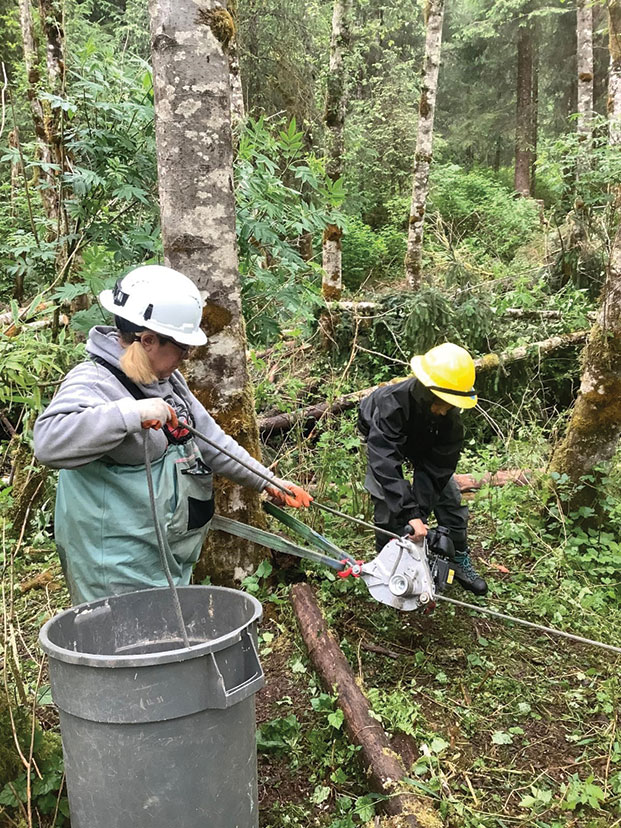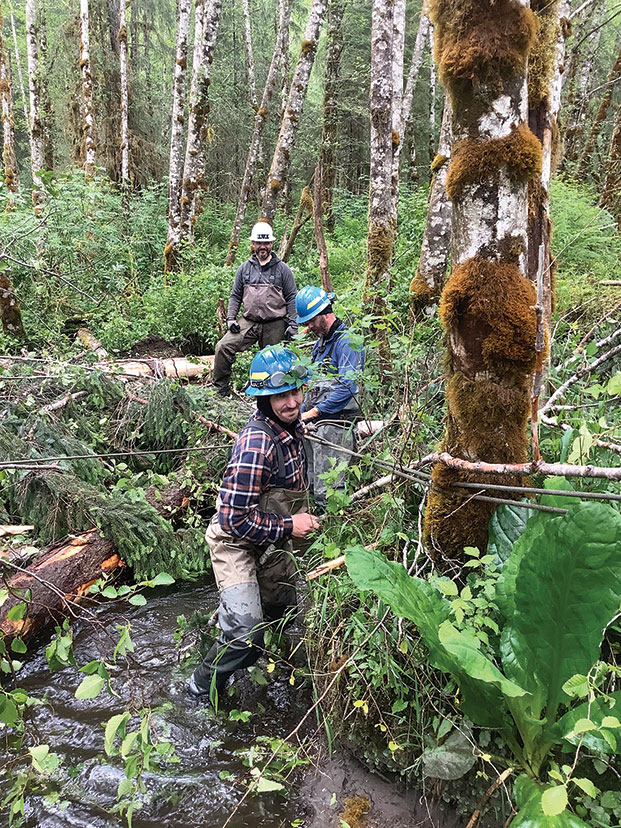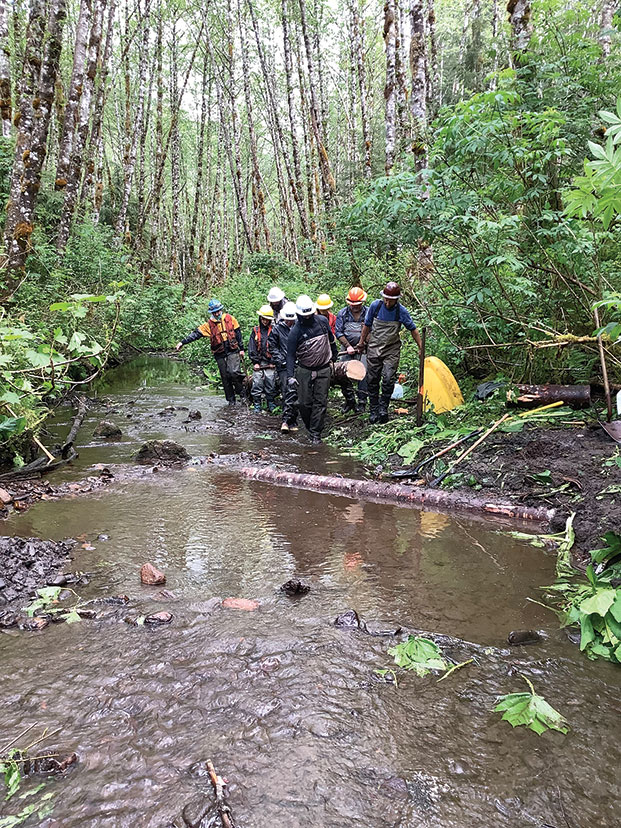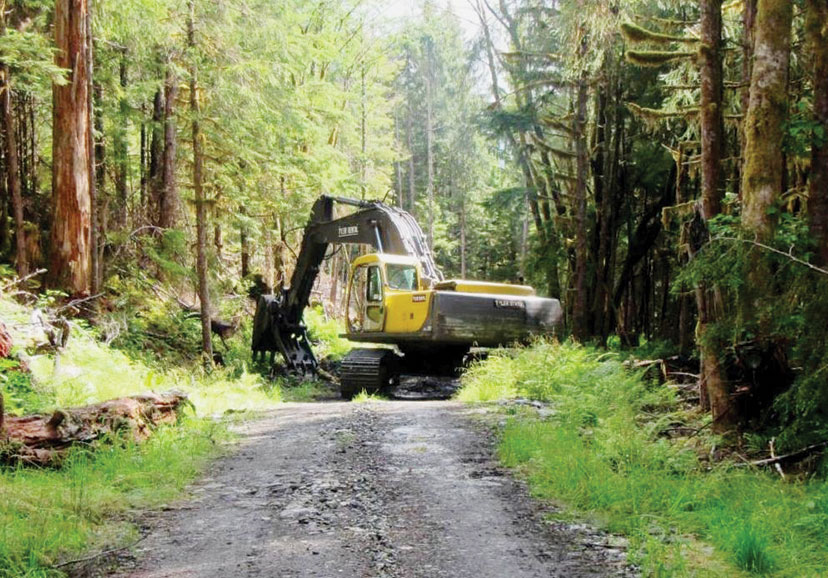Nature Knows Best: Stream restoration recreates natural features found in healthy salmon streams
Story by Marian Giannulis
Photos by Southeast Alaska Watershed Coalition
A remote salmon stream in the Tongass National Forest, 22 miles north of Ketchikan, draws in thousands of visitors who wish to witness the classic Alaskan scene of bears feeding on salmon. However, this area is not the pristine wilderness most visitors expect to experience. Margaret Creek is home to sockeye-, coho-, chum-, and pink salmon, along with steelhead- and cutthroat trout and Dolly Varden char, but logging has limited the populations of many of these species.
Intense logging from the 1950s through 1980s removed most of the old-growth trees that lined Margaret Creek and heavily damaged the area. The trees alongside salmon streams keep the water cool, stabilize the bank, and help cycle nutrients that support aquatic insects and fish. When these trees fall into the creek, they create important habitat where salmon can hide and rest. Trees provide essential functions that are necessary for healthy salmon streams. When they are removed, fish populations suffer.

Amy Hayward and Josephine Guthrie, Ketchikan Indian Community Field Crew members, use a winch to pull logs into place.

Forest Service staff Hunter Lucas and Mark Eldridge (front) and Allen Cline from KIC (back) work to position blocks to use a winch to pull a log into the stream.
The extent of the damage along Margaret Creek led the U.S. Forest Service to prioritize restoring the area. If left alone, experts estimated it could take 150- to 200 years for the trees to regrow and naturally fall into the stream. Fish populations would continue to be negatively affected without intervention. The area’s popularity as a recreation site for cruise-ship passengers on day excursions and local residents likely weighed into its prioritization. With local fish and wildlife, people, and the economy all standing to benefit, the restoration project began in earnest.
The Forest Service partnered with the Southeast Alaska Watershed Coalition (SAWC) and the Ketchikan Indian Community (KIC) for the project. Together, they completed restoration on over 1.25 miles of the creek over 2021 and 2022. Local contractor P&T Construction used heavy equipment to place whole trees and root wads in the creek. A local work crew completed the hand-tool work where heavy machinery couldn’t get access.
In May 2022, the Forest Service, SAWC and KIC hosted an in-stream restoration workshop in Ketchikan which trained Tribal crews from Ketchikan, Klawock and Metlakatla. Many of those attendees went on to work on the Margaret Creek project. This project is the first one to involve the three organizations. “It’s shared values over salmon is really what it boils down to,” said Rob Cadmus, executive director of SAWC, “and the desire, the recognition that one, the good work needs to get done to restore those same streams. And two, if we can do that work in a way that engages the community and people hear about the project and it’s successful, its impact is broader than just the actual restoration work.”
The good work completed on Margaret Creek includes the construction of 22 large woody-debris structures, the removal of four culverts that were impeding fish passage, and the removal of 1,000 feet of road fill that was blocking habitat connectivity. The hand-tool restoration work will continue to add structures to the creek through 2023.
As a result of restoration work, Margaret Creek is now much closer to its natural state. The woody debris placed in the stream helped create more of the complex habitat that fish need to survive, which had been removed by the intense logging in the area. The higher level of habitat complexity will support a greater abundance of fish. The salmon and steelhead returning to Margaret Creek, and resident trout who call the creek home their whole lives, now have many more places to hide, rest, feed and spawn.
The Margaret Creek restoration project is one of several like it happening across the Tongass National Forest. This effort is part of the Forest Service’s new strategy to move away from subsidizing clear-cut logging of old-growth forests and instead invest in restoration, recreation, and climate resiliency. This project and others like it bolster fish populations, which benefits local wildlife and communities. Restoration work benefits local economies by providing job opportunities during the projects’ construction and by benefitting the tourism and fishing sectors which make up such a large portion of southeast Alaska’s economy. Logging has caused a lot of damage to fish habitat across the Tongass, but restoration work is a great opportunity to right those wrongs and help ensure the fish we all love have strong populations for generations to come.
Trout Unlimited’s mission is to protect, reconnect and restore North America’s coldwater fisheries and their watersheds. Learn about our work in Alaska at home.tu.org/tu-programs/alaska. Marian Giannulis is the Alaska Communications & Engagement Director for Trout Unlimited.
Looking for more conservation topics? Visit our conservation blog here.



